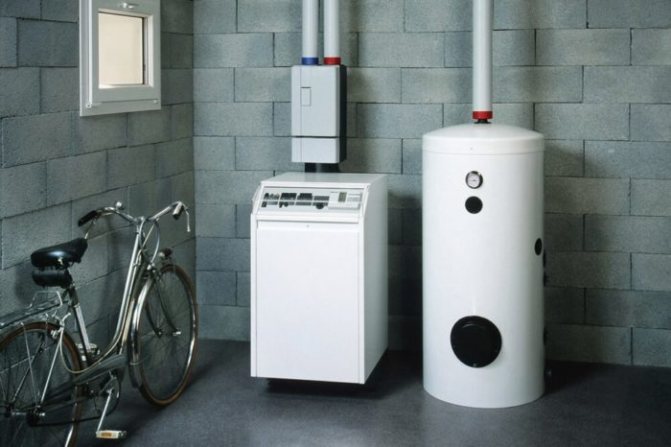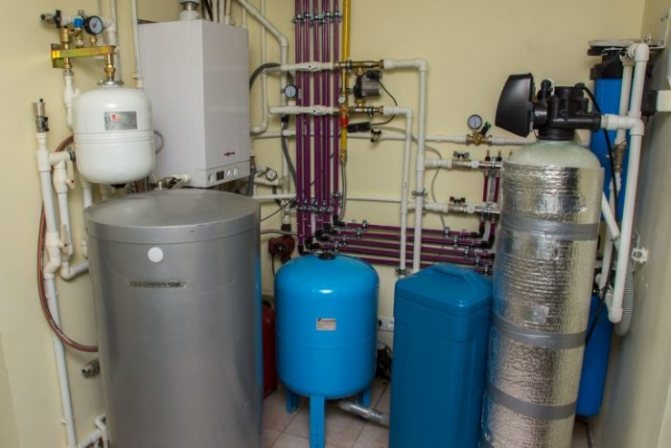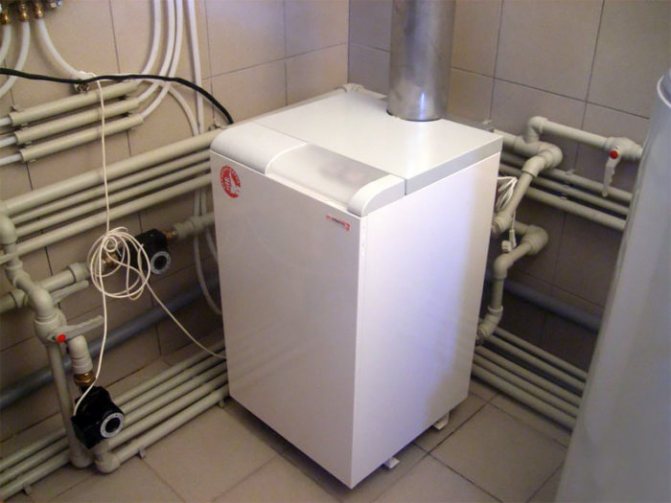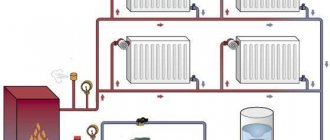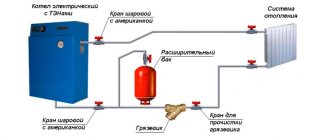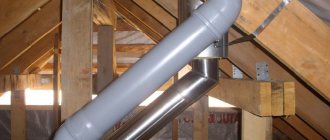AGV-boiler is a simple, but rather reliable and efficient heating device. The units have been produced since Soviet times, the products were called the Zhukovsky Machine-Building Plant. However, gradually all domestic autonomous gas apparatuses began to be called such an abbreviation.
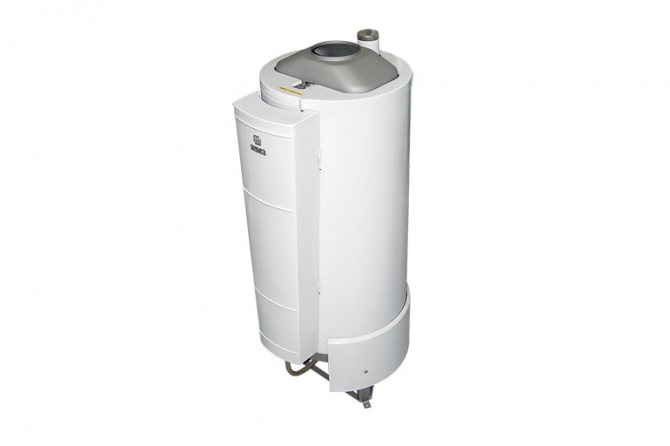
Construction and principle of operation of AGV boilers
The unit is a non-volatile device. The equipment is characterized by a simple design, which includes:
- a tank made of galvanized steel (devices are marked according to the volume of the tank);
- heat exchanger;
- burner;
- igniter;
- automation.
All AGV are floor standing boilers. The device is a tank filled with water, inside which there is a fire tube. When a gas is burned, heat is transferred through the latter to the liquid. The resulting products are discharged outside the room through a chimney connected to this device.
Water heats up and increases in volume - it becomes a coolant, which, in accordance with the laws of physics, rises through a specially provided distribution pipeline. From there, the liquid enters the radiators and transfers heat to them, which is used to heat the room. When the water cools down, it returns to the boiler through the return line. The cycle repeats again.
The AGV does not have a circulation pump and a turbofan. The nodes are independent of the availability of electricity. The circulation of water occurs exclusively by gravity, due to the difference in height between the heating tank and the radiators. Moreover, a closed cycle has been created.
Features of work
The heat exchanger is heated by gas. In this case, energy is transferred to the water that is in the container. Air comes from the room, combustion products are removed through a specially arranged chimney.
In such boilers, natural circulation of liquid is provided due to the difference in temperature conditions and the difference in height. Hot water rises upward, from there it enters the radiators. Thermal energy is used to heat the house, then the liquid cools down and lowers to return to the boiler.
To compensate for the difference in volumes, the system is equipped with an expansion tank. From the latter, the surplus goes into a special overflow tube, which serves as protection against high pressure.
The gas boiler is equipped with a solenoid valve that is connected to a thermocouple. They are responsible for the safety of the unit. During normal operation of the installation, the igniter heats the thermocouple junction. An electric current appears in the circuit. The valve itself remains open, while the gas flows at this time to the main burner. When the pilot goes out, the thermocouple junction cools down. The valve itself shuts off the access of fuel to the main burner.
The peculiarity of AGV is that you can re-ignite the igniter only manually, but not immediately, and not earlier than after 2 minutes. You can turn on the boiler after it is filled with water.
Advantages and disadvantages
The advantages of boilers include:
- low cost of equipment in comparison with other foreign and domestic counterparts;
- simplicity of design, which increases the reliability of the apparatus;
- non-volatility - such boilers can be installed even where it is not possible to provide a stable supply of electricity;
- compactness.
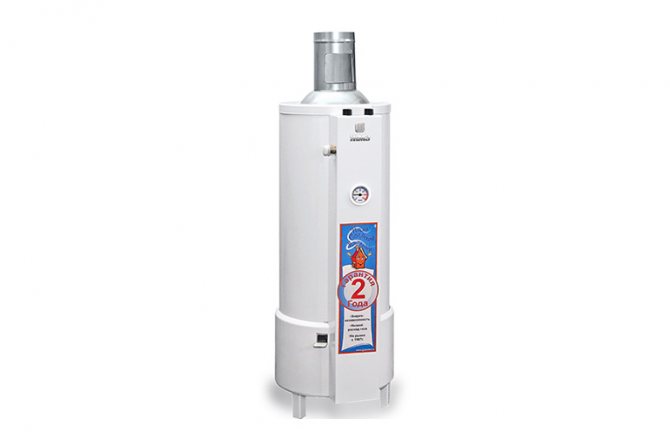

However, AGVs are not without their drawbacks. For their manufacture, not the most durable materials are used. Although galvanized steel resists corrosion, its performance characteristics are inferior to modern alloys.
Even the improved AGV models inherited the disadvantage of their predecessors. This is indicated in the operating instructions - until the water warms up to a temperature of +30 ºC, condensation may drip onto the burner.
general description
As you can see in the photo, the AGV heating unit looks a bit like a samovar. Gas boilers of this brand have been produced for a long time. Of course, over the past time, the models have often been improved, some changes have been made to the design, an automation system has been added. Therefore, the modern version of AGV is much better than its predecessor.
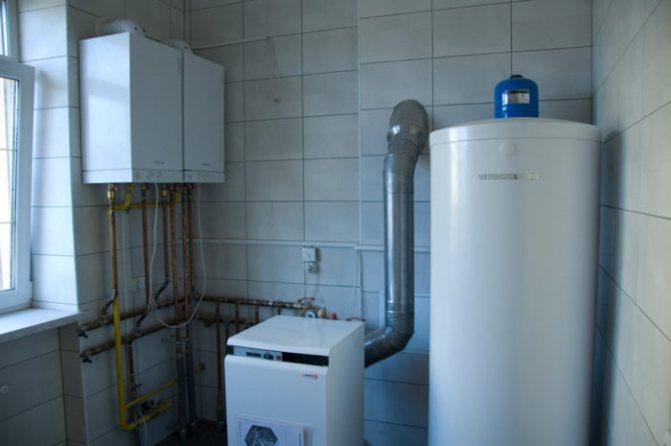

How does it work?
The design of gas boilers of this brand is quite simple. In fact, this is a container inside which the pipe is located. Hot gases pass through this pipe, giving off their heat to water, which is poured into the space between the pipe and the walls of the apparatus. The movement of the coolant is provided by the laws of physics: the heated coolant rises upward, entering the riser of the heating system.
Automation
Modern boilers AGV are equipped with an automatic control system for fuel supply to the burner. The system works like this:
- a sensor is installed inside that reacts to changes in the level of heating of the liquid;
- when the coolant heats up to the temperature set by the settings, the automatics are triggered, shutting off the gas supply to the burner, while the flame does not go out completely, a small wick remains;
- after the temperature of the coolant drops, the automation is triggered again and the gas supply is resumed in full;
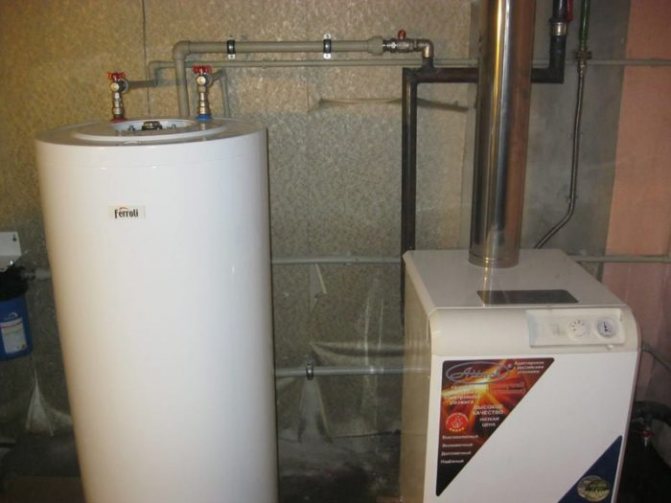

- in the event of an abnormal situation (the flame on the burner has completely extinguished, the gas supply pressure has significantly decreased, the thrust force has decreased due to a clogged chimney, etc.), the automation will block the gas supply, ensuring safety.
What is the difference between AGV and AOGV
The autonomous heating gas water heater is a 1-circuit independent boiler. The main difference from AGV is that the device is considered more reliable and safer to use. The unit is equipped with advanced automation.
For the installation of AGV, a separate room is required, since the combustion air is taken directly from the room. Good sound insulation is required as a loud bang is heard when the appliance is turned on. AOGV eliminated this drawback.
When the water reaches the maximum temperature value, the burner is switched to the minimum flame mode, but does not turn off completely. A separate room for AOGV is also not required, since a chimney with a size of 140 mm is laid through the wall, air is taken from outside. It is only important to install a special waste container under the pipe for waste that accidentally falls into the channel.
Boiler gas path
The design of the boiler provides for a fan forcing combustion air into the boiler furnace. The generated pressure is sufficient for the combustion products to be forced through the heat exchanger, leaving through the chimney. This is a closed view of the firebox. Here, the air volume is as close as possible to the ideal volume, due to this, the amount of heat that goes into the gas duct is minimal.
Some boilers assume the creation of the draft necessary for combustion with the help of a chimney. This is a type of boilers with open hearths, it makes the design somewhat cheaper. But when there is no fan in the boiler, the efficiency indicator decreases, and the requirements for the pipe increase. For example, for boilers with a fan, the chimney can be led out through the wall vertically, for a boiler with an open firebox this is not possible.
Read how to clean and where to buy brick heating ovens. What are the requirements for installing a gas boiler, see here.
Elementary about the viessmann gas boiler, reviews:
A plus for a boiler with a closed firebox will be the fact that before the gas is supplied and after it is turned off, the firebox is blown out, this reduces the risk of pops in the firebox. In some cases, the fan is replaced with a smoke exhauster.
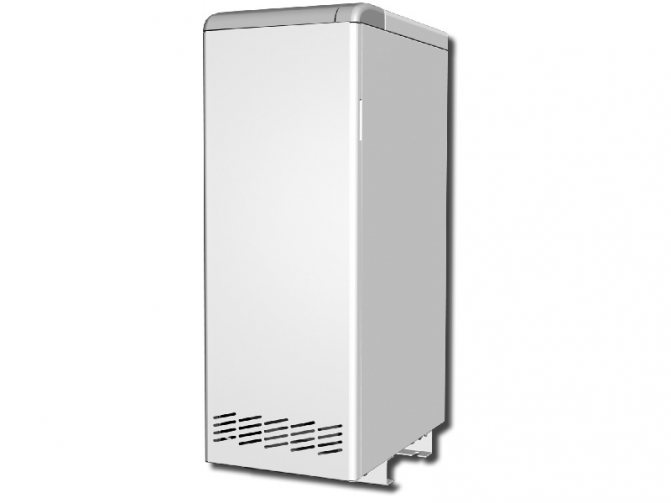

Floor-standing boiler OAGV (Lux is non-volatile)
Thanks to the use of the energy of the gases leaving through the coaxial chimney, it is possible to supply the already heated air to the boiler. If the temperature of the air in the combustion chamber is increased, this is favorable for the process itself: the ignition improves, the torch burns evenly, without delaying combustion, this provides better heat removal.
In reality, the increase in temperature for this reason is not too noticeable if cold air comes from the street. But the overall efficiency indicators increase, since savings are obtained on heating the air that enters the house ─ the boiler sucks in air from the room and removes it through the chimney.
Modern heating AGV
Compared to Soviet models, the manufactured devices have become convenient and functional. They are equipped with automation that makes the operation of the boilers comfortable for the user.
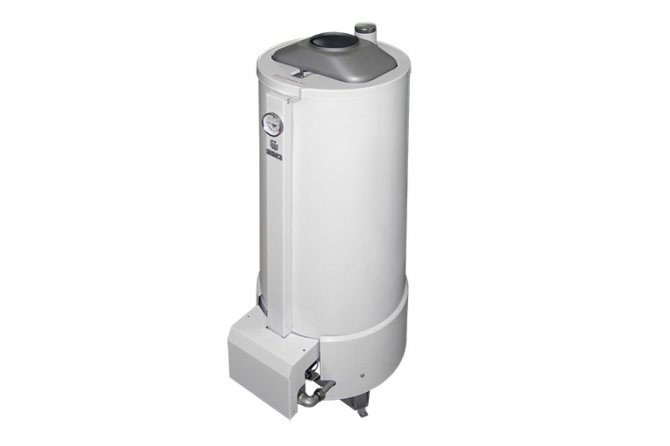

In modern models, there is a thermal sensor required to control the set temperature. A chimney draft control component is often installed. The functioning of the automation is carried out due to the electric current generated by the thermocouple. The latter produces it due to heating. This ensures the activity of the electromagnet, which makes it possible to control the gas valve. This also increases the reliability of the operation.
To choose the right model, take into account the characteristics of the equipment.
Modern AGVs are switched on with the help of a piezo ignition, which is more convenient than before. The automatics are mainly American, and the thermometers are Italian. New coating technologies have contributed to the attractive finish of the case.
How to use AGV
AGV boilers are still used in everyday life. The fact is that their ease of use and low cost attracts many older people. Moreover, new models can be no worse than other modern boilers.
Installing a gas boiler is not an exercise for a common man in the street. Firstly, such work presupposes the presence of certain knowledge and experience, and secondly, the unauthorized installation of a gas boiler is an offense that is punishable by law.
The most difficult thing in using AGV is its installation. Install such a unit on your own, no instructions will help you. And the gas services will not allow such an experiment. However, so that you can follow the work of the masters, we will give you some tips on this matter.
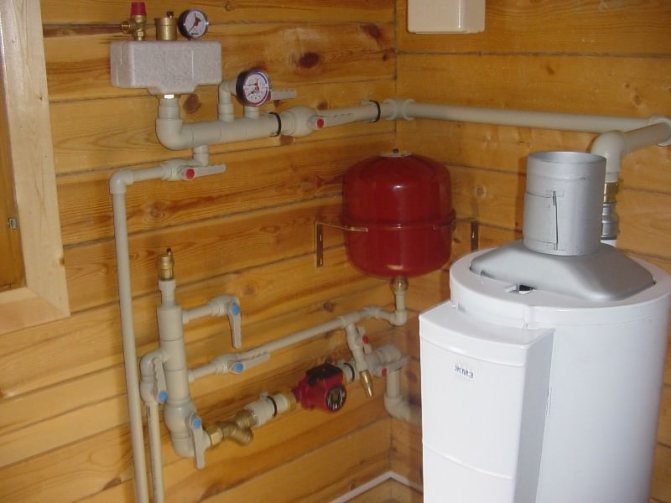

Rules for using AGV:
- Such a boiler is installed in a separate room;
- The chimney must be insulated and led out into the street, and the diameter must be at least 135 mm.
- Only gas service employees can connect the boiler;
- To prevent debris from entering the gas column, a pocket is installed in the chimney into which it will fall;
- The AGV boiler is installed below the level of the radiators.
This knowledge will help you choose a place for the location of the boiler and control the operation of gas services. Please note that the first start-up of the boiler must be carried out in the presence of installers so that they can eliminate the problems that have arisen in time. Then you can use AGV yourself, observing the recommendations given by the manufacturer.
User's manual
The main thing to remember is that such boilers do not have a built-in circulation pump. Good natural traction is required. This is possible only if ventilation is established in the room where the AGV is installed, and the chimney is arranged according to all the rules.
The installation features are as follows:
- duct height is at least 5 m with a total length of horizontal sections up to 3 m;
- the diameter of the pipe corresponds to the size of the outlet of the apparatus;
- do not connect equipment to exhaust ventilation ducts;
- a small hatch is arranged under the vertical part of the chimney to clean the system from condensate;
- when installing AGV, you need to make sure that there is a free passage in front of the device at least 1 m.
The recommended distance from the unit to the nearest wall is 2 m or more, this is the only way to ensure fire safety. The finishing of the vertical surface must be made of non-combustible material. If the owner doubts its properties, it is better to install a screen made of sheet asbestos.
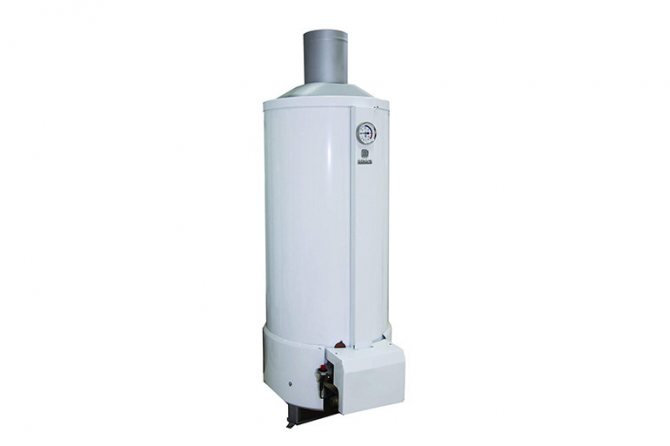

Installation of AGV necessarily implies the connection of equipment to gas networks. You cannot do this on your own, you need to contact the specialists of a company that has a license to carry out the work.
As for the operating rules, the equipment is launched in the following sequence:
- First you need to check if the heater tank is filled with water.
- Then they look at the presence of draft in the chimney. This can be done using a thin paper flag. If there is no thrust, it will remain stationary. This is important as there is a risk of poisoning from unburned fuel.
- Open the valve mounted on the gas pipeline.
- The burner is ignited (with a match or a piezo ignition handle - depending on what type is provided on the model). Then only the igniter is turned on. After that, you can open the tap in front of the main burner. It should be powered by an igniter. It is recommended that you read the instructions first.
- After turning on the AGV, check the presence of draft in the chimney again.
- Close the firebox door.
If the igniter goes out, then you can re-ignite it only after a few minutes. When the water heater is running, it should be on constantly.
The AGV is also switched off sequentially. First you need to close the gas taps. They are installed in front of the main burner and the appliance. In the AGV-120 model, the pilot valves are closed separately and in front of the boiler.
The units do not need special care. The main thing is to provide protection against mechanical damage and liquid ingress, if the device is installed so that splashes from a shower cabin or a water tap reach it.
The operation of the device should be monitored. The flame has a bluish tint and the length of the tongues is 30-40 mm. If it starts to smoke, you need to slightly open the windows for oxygen to enter the system. When the smell of gas is felt in the air, specialists are immediately called in. Before the arrival of the emergency team, close the tap in front of the equipment and ventilate the room. At the same time, turn off electrical appliances and lighting to avoid sparking anywhere.
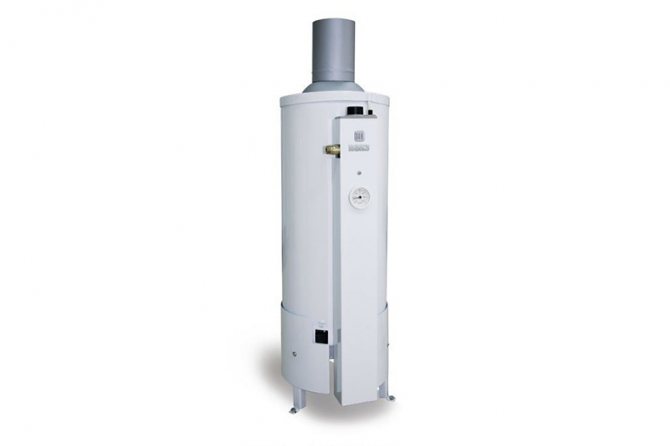

Model overview
The model of the gas boiler AGV 120 differed only in greater power. It had all the shortcomings of the basic device, so it cannot be called a next generation technique. The not very successful internal design led to a situation where part of the received thermal energy flew into the pipe along with the combustion products. It was possible to eliminate this defect on your own by changing the furnace device, but such a modification was associated with a certain risk. With an incorrect calculation, it was possible to achieve the effect when the exhaust gases ceased to be discharged into the atmosphere and remained directly in the room. In this case, it was necessary to carry out the entire procedure in a new way.
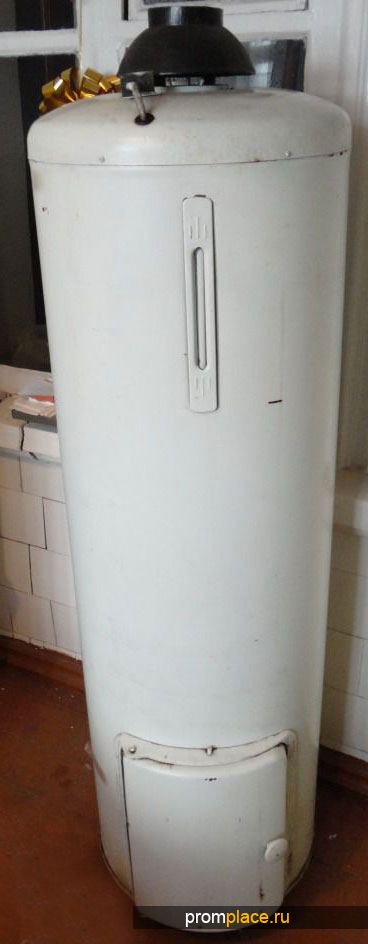

The AGV 23 gas boiler was a more successful modification. In it, some shortcomings have indeed been eliminated, which made it more ergonomic and convenient to use. Among the main improvements, it should be noted:
- - lower noise level during operation;
- - improved automation, which has become more functional and reliable;
- - by changing the principle of chimney installation, it was possible to slightly increase the level of efficiency and the overall operational efficiency of the unit;
- - the burner received protection against condensation, which in previous models could easily extinguish the flame.
In general, AGV gas heating boilers were a very successful invention for their time. They allowed people to switch from solid fuel systems to more modern and convenient gas counterparts. This was an important step towards the complete elimination of environmentally harmful heaters. Now solid fuel models in everyday situations are used only in extreme cases. Most of the users have switched to gas or electric systems.
The price of gas boilers AGV is negotiable. They were taken out of production a long time ago, so the purchase can only be made on the secondary market.
Foreign autonomous gas water heaters
Non-volatile boilers are popular. Imported units differ from AGV in a wide variety of models. However, more often these are floor heating devices. Wall-mounted options are rare.
But there is a variety, like parapet non-volatile boilers. They can be installed on the floor or hung on the wall (but not higher than the level of the windowsill). There are models that are mounted on a vertical surface.
Imported non-volatile devices also differ in the materials from which the heat exchanger is made. For example, stainless steel, cast iron or copper. The latter is considered expensive, but also the most reliable and durable option. Copper is not used for the production of AGV.
Equipment of the Slovak brand Protherm is popular. The models are named after animals. The Protherm Medved 20 TLO boiler is considered practical and powerful. The device is equipped with a heavy cast iron heat exchanger.
The unit has a higher efficiency compared to AGV - about 90%. This model is suitable for heating a house with an area of up to 200 m² (excluding heat loss), although the power is 18 kW.
From foreign devices, the Baxi boiler is popular. SLIM EF 1.22. The device is characterized by a high power of 22 kW, but the efficiency is lower than that of other imported units - 88%.
Criterias of choice
When buying boilers for a private house, several aspects are taken into account:
- The area of the heated room.
- Possible heat loss (depending on what materials the walls of the building are made of, floors and ceilings, windows and doors are made).
- Equipment power (the required indicator is calculated on the basis of 1 kW for every 10 m² of the area). But if the house is located in a region with harsh winters or is built from materials with high heat loss, the resulting figure is increased by 25%.
- Functional features of the boiler.
AGV are produced in different capacities, but the standard indicator is enough for heating a house up to 120 m². For buildings large in area, foreign autonomous boilers are bought. Additionally, improved AOGV or AKGV devices are considered as an alternative solution.
The latter is a complex water heater. These are double-circuit boilers that operate independently of the mains. The units provide heating and hot water supply.
However, experts believe that it is impractical to install such equipment in houses with an area of 200 m² and more, since it is impossible to create a stable natural draft. You will have to buy an additional circular pump, and to it - a UPS and a generator to ensure operation. Such disadvantages negate the advantages that the autonomy of the boilers gives.

